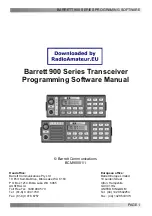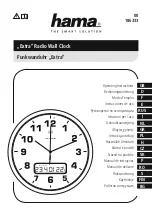
TM8100/TM8200 Computer-Controlled Data Interface (CCDI) Protocol Manual
CCR
53
© Tait Electronics Limited
April 2007
2
CCR
2.1
Introduction
Overview
This section provides details of the Computer-Controlled Radio (CCR)
protocol, version 2.00. It describes the radio to Data Terminal Equipment
(DTE) protocol. This is an advanced radio control feature.
Note
CCR applies to TM8100 radio terminals only.
The CCR protocol provides a means of temporarily reprogramming a
channel from some form of DTE via a serial interface (PC, AVL application,
Telemetry Application, MDT).
In CCR mode, the radio no longer uses a non-volatile database. A number
of radio parameters are uploaded and changed during run-time from an
external application. In this way, the external application provides the non-
volatile data storage.
All serial ports on the radio support CCR (Microphone, Auxiliary and
Internal Options).
The CCR mode is a sub-mode of CCDI. Entry into CCR is via a CCDI
command (“f0200D8”). Once, in CCR mode the radio will accept serial
CCR commands and will no longer process CCDI commands.
The TM8100 series of radios are able to support USER, CCDI Transparent
and CCR modes of operation.
Benefits
Most of the radio functionality can be controlled by the external device
operating over a serial communications link. This allows system integrators
to develop their own intelligent control device. They can develop complex
solutions with a low cost RF platform.
In essence, a radio which has access to all the channels in its operating range
could be made. The limit is no longer in the mobile but in the external
intelligence driving it. A wider range of methods can be employed to alter
or modify the way the radio is controlled by the user; a step forward in
control evolution.
2.1.1
Configurable Parameters
Channel information:
■
Tx/Rx frequencies
■
Tx & Rx CTCSS/DCS frequencies
















































